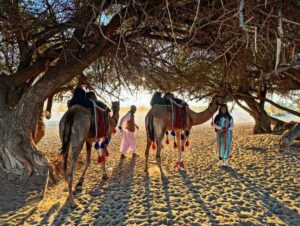In 2013, writer Paul Salopek set out on an audacious expedition that was also an intimidating piece of method journalism: He would retrace mankind’s earliest footsteps on a 34,000km walk he christened Out of Eden.
It’s almost impossible to comprehend the earliest human migrations. Our ancient ancestors set out from the Horn of Africa, crossed sweltering deserts and inched their way into Arabia with no knowledge of what lay ahead of them. Fossil records show a gradual march through the Middle East and into Asia. Eventually, a few brave, desperate or foolhardy souls pushed over the Bering Land Bridge into the Americas. Equally incredibly, early Polynesians rode the waves and their luck, hopping along the strings of remote islands that dot the Pacific.

The spread of modern humans (light blue lines) and Salopek’s route (red line). Photo: Paul Salopek
Salopek is significantly better equipped than our Stone Age forebears. His load includes GPS trackers, solar panels and all the tools of modern communications: a laptop, high-tech camera gear and a satellite phone. Crossing northern Ethiopia and the Afar Triangle into Djibouti, camels bore the brunt of the load.

Thanks to dromedary camels, Salopek was able to take some serious kit through Ethiopia and Djibouti. Photo: Paul Salopek
The Afar region has the hottest year-round temperatures on Earth, yet Salopek was far from alone in this incredibly inhospitable place. After dark, columns of migrant workers and refugees shuffle towards the Red Sea coast to seek passage to the Middle East and perhaps, a better life. Some will die of thirst along the way, others drown when old, overcrowded boats capsize in the Gulf of Aden or the Red Sea. Salopek’s own odyssey also required crossing to Arabia. After 100 days and over 500km of walking, he secured passage on a huge container ship, packed to the gills with 8,000 sheep, 855 camels and 24 humans.

An Afar man leads his camels, loaded with salt, out of the Danakil Depression in Ethiopia. A donkey, used to lead the caravans, waits for his charges to catch up. Photo: Martin Walsh
Disembarking in Jeddah, Saudi Arabia, Salopek was joined by a Bedouin guide for the long march out of the Arabian peninsula. Along the way, he shared camp with some of the few remaining nomads and was visited by a man in dire need of a nickname: Prince Sultan bin Salman bin Abdulaziz Al-Saud, president of the Saudi Commission on Tourism and Antiquities and the eldest son of the Crown Prince of Saudi Arabia. The long, hot trek toward Jordan took longer than expected. Extreme heat forced Salopek to wait out the height of summer before continuing.
The war in Syria then forced Salopek west and north as he made his way out of Jordan. He first entered Israel, where he was mistakenly shot at by the IDF (Israeli Defence Force), then continued through the Mediterranean, by way of Cyprus, to Turkey.
En route, he encountered the ripple effects of the Arab Spring and Syria’s collapse: laid-back Anatolian villages juxtaposed with the “largest forced migration in the Middle East since the fall of the Ottoman Empire.”

Migrants near the Djibouti-Ethiopia border. Photo: Paul Salopek
Salopek diverged from some of humanity’s original route because of very modern barriers, “not of ice, but of … borders and visas.” He failed to obtain permission to entrer Iran and instead detoured north through the Caucasus to Georgia. In early 2016, he crossed into Azerbaijan, took a boat across the Caspian Sea and began trekking the vast steppes of Central Asia.

One of Salopek’s many walking partners makes his way through the snow toward the Georgian border in Turkey. Photo: Paul Salopek
Every stage of his journey has unearthed new stories, a process Salopek calls slow journalism. In Kazakhstan, Uzbekistan and Kyrgyzstan he saw how the ancient Silk Road has fallen by the wayside of history. In the Wakhan corridor between Tajikistan and Afghanistan, he found community-led conservationists fighting to re-wild their homes. Everywhere he has encountered a sad reality of our time, mass species extinction and “wild habitats shunted aside by roads, factories, industrial farming, and exploding mega-cities.”

The Wakhan Corridor, on the edge of the original roof of the world. Photo: Paul Salopek
Salopek originally figured that he could finish the project in seven years, reaching Tierra del Fuego, at the very tip of South America, in 2020. But delays — summer in Saudi Arabia, winter in the Tian Shan and politics in the Middle East — have pushed this back substantially. Six years in, Salopek has only just crossed the Indian subcontinent. Now, as he approaches Bangladesh after over 2,300 days and almost 10,000km, his final destination remains a veritable world away.






